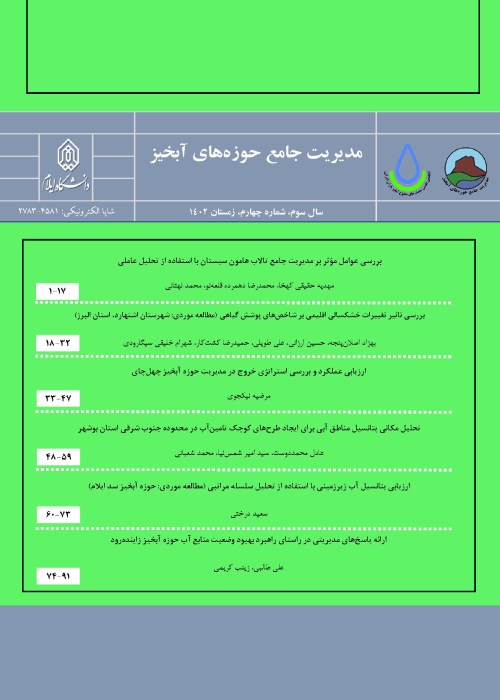Evaluation of IHACRES models and neural-fuzzy inference system in forecasting the runoff of the Kurit dam catchment in the future period
Today, the increase in the concentration of greenhouse gases in the atmosphere causes changes in the components of water resources on a global and regional scale. On the other hand, forecasting the river flow in the future period is considered a basic tool in water resources management. The rainfall-runoff process is completely non-linear, and it is completely random in terms of time and place. Therefore, it is not possible to easily describe its mechanism using simple models. The IHACRES hydrological model is used to simulate precipitation and runoff in large basins and most weather conditions, and it is also an integrated and conceptual model. The main advantage of this model compared to other rainfall-runoff simulation models is the acceptable accuracy of the results along with the use of minimal input data and its simple structure. The aim of this research is to compare the performance of IHACRES models and the fuzzy neural inference system in the simulation of the outflow of the catchment of Kurit Dam in Golshan Tabas and its forecast in the near future under the RCP4.5 scenario and the large-scale GISS-E2-R model.
In this research, the performance of IHACRES models and Adaptive Neuro-Fuzzy Inference System (ANFIS) in forecasting the runoff was investigated. Model performance comparison of these models introduced the superior model. To simulate the future climate, the downscaling LARS-WG5.0 model was used under the RCP4.5 scenario. The temperature and precipitation data of the output of the large-scale model of the fifth GISS-E2-R report of the American country were extracted from the site. The precipitation and temperature data from 2022 to 2051 were downscaled and then the discharge values for the mentioned years were estimated with the superior model. The input data to the IHACRES rainfall-runoff simulation models and the ANFIS model include rainfall and temperature on a monthly scale. In this research, 60% of observed precipitation, temperature, and runoff data were used for training and the remaining 40% of data were used for validation of ANFIS and IHACRES models. After calibration of the two models, evaluation was done using RMSE and NS indices.
Investigation of linear correlation between precipitation and temperature with observed runoff showed that there is a significant relationship between precipitation and runoff in low and high monthly precipitation, but changes in observed runoff and temperature do not have a significant correlation (at the 95% confidence level). The evaluation criteria of RMSE and NS in the validation section of the IHACRES model were calculated as 0.1 and 0.95 respectively, and for the ANFIS model as 0.05 and 0.52 respectively, which shows the superiority of the IHACRES model over the fuzzy neural inference system model at this stage. In order to complete this section, as explained in the research method section, the LARS-WG5.0 software was used for downscaling of precipitation and temperature output of the large-scale model GISS-E2-R in the near future (2022-2051) under the RCP4.5 scenario. Extracting the long-term monthly average showed that the average values of precipitation and temperature in the future horizon are equal to 17.38 mm and 21.7 °C, which, compared to the same values in the base period, shows that an increase of 5.45 mm in the average monthly precipitation and 2.9 °C an increase in the average temperature will occur. It can also be expected that this change in the values of climatic parameters will cause changes in the runoff caused by precipitation in the future. After simulating the monthly rainfall and temperature data from 2022 to 2051 by the LARS-WG5.0 downscaling model, these data were given as input to the IHACRES model to simulate the discharge by this model for the near future time period. Based on the results of flow simulation by the superior model (IHACRES model), the flow rate in the river will increase in the near future horizon.
In this research, In order to evaluate the IHACRES models and the adaptive neuro-fuzzy inference system, the available data (2013-2018) were divided based on the ratio of 60% to 40% for calibration (2013-2016) and validation (2016-2018). The validation result showed that the IHACRES model was more capable than the neural-fuzzy inference system model in simulating the observed runoff at Mavder station. The American GISS-E2-R large-scale model and the RCP4.5 scenario was used as input of hydrological model to simulate the runoff in the near future horizon. The results of statistical downscaling by LARS-WG from 2022 to 2051 showed an increase of 2.9 °C in temperature and an increase of 5.45 mm in total monthly precipitation. The output of the downscaling model was used as the input to the superior IHACRES model to simulate the runoff in the near future horizon for the investigated watershed.
- حق عضویت دریافتی صرف حمایت از نشریات عضو و نگهداری، تکمیل و توسعه مگیران میشود.
- پرداخت حق اشتراک و دانلود مقالات اجازه بازنشر آن در سایر رسانههای چاپی و دیجیتال را به کاربر نمیدهد.



